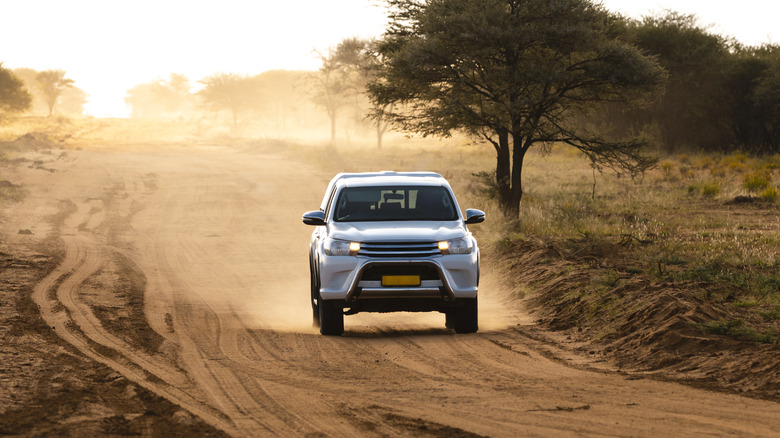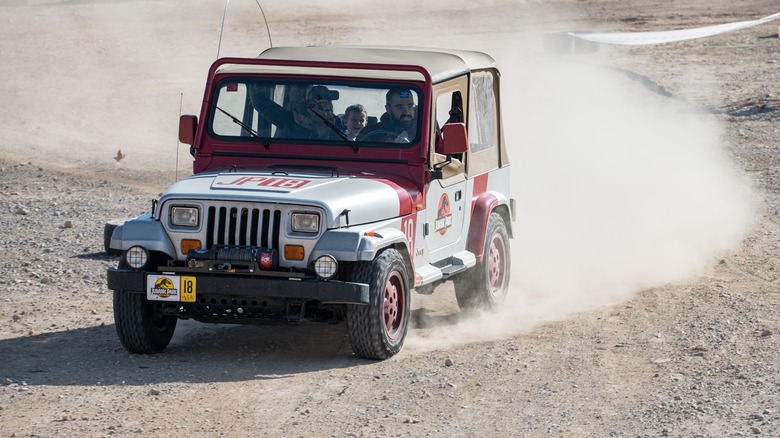How Fast Can You Safely Drive With Your Truck's 4WD Engaged?
Many modern and classic 4x4 SUVs and trucks feature part-time 4WD (four-wheel drive), generally with a system which requires an input that the driver can engage at any speed. But is there such a thing as an "unsafe" speed to operate a 4WD, given the name part-time? There's a lot of different types of 4WD, from your basic transfer case up to highly-advanced AWD (all-wheel drive) units on cars like the Audi Quattro AWD system. Here, we'll discuss manually-operated 4WD systems using a chain-driven transfer case with 4H (four-high) and 4L (four-low) modes, the most common format for a part-time system. This doesn't apply to full-time 4WD-equipped vehicles, which, as the name implies, can be safely driven in full-time 4WD mode at any speed all the time.
I've owned and driven a variety of 4x4s equipped with part-time 4WD since 2008, as well as worked on a number of their driveline components over the years. From my experience, for normal driving, you should use 2H (two-high) or full-time 4WD if your truck has it. 4H is good for most off-road situations, but nothing over 55 mph on paved roads except if you're having major traction issues. You can shift into 4H at any point, but doing so under certain conditions may end up hurting your vehicle's driveline components, and yes, that includes speed. So what factors affect your transfer case if you exceed these general operating speeds for 4H and 4L? In order to answer this question, we'll have to lightly dig into what a transfer case is, how it works, and how speed might affect all that.
Driving in 4H at speed
With chain-driven transfer cases being so ubiquitous, let's look at how they work and if you can put on 4WD at a higher speed. While my '96 Cherokee's owner's manual doesn't explicitly state any hard speed limit deemed to be "unsafe" when in 4H, I've always limited my speed to 55 with this setting engaged — this seems to be the average speed many other drivers take as well. The reason for this comes down to how these transfer cases function.
A part-time transfer case system links your front and rear axles so they rotate at the same RPM. As such, it cannot sense if your front wheels need more or less torque like a more sophisticated full-time system. It also doesn't know whether or not your front or rear axles want to spin at different speeds (such as in turns or under heavy load). What this means is that you may end up over-torquing or over-heating the transfer case at faster speeds by asking it to deliver too much torque to one axle. This places a lot of stress on the whole system and can lead to numerous problems, from a broken tooth in the chain-drive to cracks developing in the transfer case's aluminum housing.
The only time I would ever consider running 4H at speeds above 35 mph is if it's heavily raining or snowing. Most 4x4s, new and old, are designed to work fine in 2H in most weather, with a good set of tires playing a big role in everyday traction.
What about using 4L?
4L is different from 4H because it uses a gear reduction to multiply the torque at low-speed by allowing the engine to rev higher, like a crawler gear. My Jeep's transfer case, for instance, features a 2.72:1 reduction, which means the driveshaft rotates 2.72 times slower than normal for a given RPM and gear. Because 4L is a step-down, it should only be engaged when stationary and in neutral. You should never engage 4L while at higher speeds because of the danger of over-revving. This setting will multiply the stresses on the system by the rate of the reduction, so round it up to three in this case. That means you're putting three times the stress through the transfer case for a given vehicle speed as it would be in 4H, hence why speeds must be as limited as they are in this mode.
You should also only use this setting up to around 10-15 mph or so. The standard use for 4L is if you're stuck in very poor conditions or need the torque advantage when setting off with a heavy load, like if you're towing. It's not designed to operate at any reasonable traffic speed, and certainly not for any extended amount of time.
For most applications, simply running your truck in 2H is perfectly adequate, including during inclement weather like rain and storms. It's only when you start slipping that you should consider changing to the proper 4WD setting.


